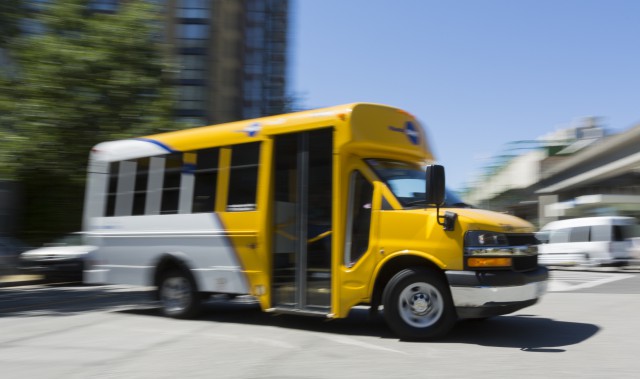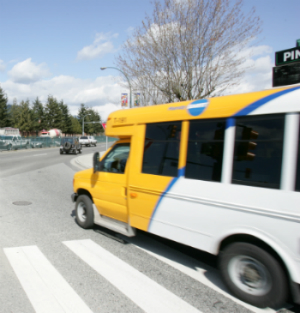Custom transit, HandyDART, and the Taxi Pilot Project: what’s going on?
Custom transit, HandyDART, and the Taxi Pilot Project: what’s going on?

One of the topics we haven’t often addressed on the blog is the custom transit part of our transit services – HandyDART. HandyDART is a door-to-door shared ride service for people with disabilities.
Just like the conventional transit system, demand is up for HandyDART. People who use conventional transit sometimes experience pass-ups, especially on our most heavily used routes. On HandyDART runs, we can record these as trip denials – a customer requests a trip and there isn’t one available for the time requested.
As demand goes up, so too have HandyDART trip denials, and this is a big concern for us. (It’s worth noting that we started to more accurately record denials data in 2010, which resulted in a marked uptick in the number of denials.) TransLink has been managing this by getting more efficient with operations, including HandyDART (service optimization, anyone?).
Today, HandyDART provides more trips to customers than five years ago – 1.21 million in 2012, compared with 1.17 million in 2008 – using approximately the same number of annual service hours. 3% of all trips were denied in 2012.
Testing solutions: the Taxi Pilot Project
When you think of HandyDART, the distinctive yellow and white buses probably come to mind. But HandyDART isn’t tied to just one type of vehicle. For example, using taxis is a practice already used successfully here and in other North American cities.
Using taxis to provide some HandyDART trips is one way to provide more rides with the same number of service hours. This year, we’ve had a Taxi Pilot Project underway, which has moved about 10,000 hours of service usually delivered by HandyDART vehicles to taxis (less than 2% of annual HandyDART service hours). Taxis provide this service in areas and at times when our regular vehicles would not be very full.
This is still a HandyDART service, and does not reduce overall HandyDART service. Customers get door-to-door service, pay the same fare and book their trip in the same way. If they have a concern, they contact HandyDART customer service, just as they would for a trip on a HandyDART vehicle.
With the Taxi Pilot, we expect to deliver 7,000 more trips this year to our HandyDART customers. Those who are able to make a trip by taxi on select routes will have that service, thereby freeing up trips for others whose needs are best met by HandyDART vehicles. As it is a pilot, we’re closely monitoring the outcomes, and listening to what our customers tell us as part of our evaluation.
Addressing custom transit challenges

Trip denials aren’t the only thing we need to focus on when looking to provide more HandyDART rides with our current funding and resources. A couple of the other issues we’re grappling with:
- Cancellations at the door and “no shows” for our HandyDART service are also very high — in 2012, there were almost 22,000 of these types of cancellations, which are disruptive to service and can increase trip denials.
- HandyDART demand is up, and we know the number of seniors in our region is projected to grow, but so far we haven’t seen a similar rise in the number of HandyDART customers or even HandyDART applications (the latter may even be decreasing). This suggests that we have to look at all the ways our region can improve transportation services to this group – not just HandyDART – such as improving the accessibility of the conventional transit system.
We’re working to address these and other challenges through an ongoing Custom Transit Service Review. We’ve been through a couple rounds of stakeholder consultation, with another round planned for 2014, and it’s bound to garner a lot of conversation.
It’s clear from the lively conversations that take place here on the blog, that many of our regular readers recognize there is a lot of pressure on our transit system. Even though people want and need more transportation services, the financial reality is there are no new funding sources to pay for more. It’s not always easy to find solutions that make everybody happy.
Let us know your thoughts in the comments section below, and if there are any questions we can answer about HandyDART.
Author: Tina Robinson






@ Translink
“Let us know your thoughts in the comments section below, and if there are any questions we can answer about HandyDART.”
Have reader and rider suggestions ever influenced the spending decisions? Even in aggregate? I find that hard to believe.
I’ve brought up a similar comment before, but this time it’s a little different. I personally believe that once the governments have identified their own spending priorities and the money sources, then the decision is pretty much cast in stone.
It would be like somebody saying, “Do you want grapes or apples? Grapes? Okay, well, we can’t afford that, so we’ll give you apples. The money that would have paid for grapes has all ready been allocated for a big feast for people who hate fruit and vegetables. It was such a great deal that we couldn’t turn it down”.
Perhaps you’re not looking for suggestions. Perhaps you’re letting people vent. Perhaps you’re trying to give people a chance to speak, so that you can change their thinking.
I don’t mean to be rude. I’d really like to know of any comments that made a difference to spending large amounts of money.
Hi Eugene, thanks for your comments.
We take into account all customer comments and feedback. The Buzzer is just one of the channels for hearing from our riders. Our customer information team, for example, logged 1.7 million voice calls in 2012 (of 4.5 million calls that came in). We log every single call, as well as web and Twitter feedback, and track the types of complaints and suggestions we receive. We monitor if there are trends in what we’re hearing, and make change if it’s technically and financially possible.
We also forward on blog comments to appropriate people. There have been times where real changes have taken place due to Buzzer comments, like when we moved a sign on the Knight Street Bridge that was blocking the bike path. It might seem minor, but we action what we can.
As for the big picture things, spending decisions have to take into account a lot of factors, including the various regional needs, funding, and balancing different (sometimes conflicting) priorities. We’re trying to do the best we can with the resources we have, and taking into account the feedback we receive from riders as much as possible.
If you remember a ways back (I believe we were talking about service optimization) I made suggestions about some of the mainland New West routes. The #128 is obviously inspired by that, even if it’s not as ambitious as you and I talked about Eugene.
So that’s one partly done, at least half of the routes to go…
@ Sheba and Tina
Thanks for the comments. Those are good points.
I just think that although you should always welcome comments, you shouldn’t encourage them. It only raises expectations. In the food example, if you can’t offer anything other than apples, and if lots of commenting and begging won’t make a difference, then it’s dishonest to welcome suggestions for changes to the menu. I consider that to be a mild form of bait and switch.
I’m with you Eugene – what’s the point in asking for suggestions (as has happened on this very blog) if they’re only going to be foldered.
Something I’ve done, as much for my own benefit as for any other use, is to take regional maps (esp Burnaby) and draw each bus route in in it’s own color. I knew Burnaby had a fair amount of route overlap but when I saw it drawn on a map like that in technicolor it was pretty shocking just how much there is. It’s actually been pretty fascinating to me to try to make what I think is a more sensible route map without completely starting over.
If you start with TransLink’s pdfs the first map is fairly easy to do. Trying to make a ‘new and improved’ map is harder than you’d think it would be.
@Sheba and Eugene
Thanks for your comments, guys. You make a good point, Eugene, about the ask for feedback. We certainly don’t want our readers to feel like we don’t take their comments into account, which is why we ask for feedback, but what we hear is in the context of the comments/feedback we get from all our riders through a variety of channels.
“the financial reality is there are no new funding sources to pay for more”
I thought there was a referendum coming up on increasing transit funding so the whole transit system can be improved. The most reliable voters (seniors) seem to value HandyDART service, so it would seem logical to include improvements in the package being voted on if you want to win. Or has the referendum been cancelled?
@Eric
Thanks for the question. The Province has committed to holding a referendum on transportation funding in 2014, scheduled to take place sometime before the November municipal elections. The discussion on the details about timing and the question is between the Province and the mayors of the region. In the meantime, TransLink manages the transit network with existing funding and resources. Until a sustainable source of funding is identified and approved, it means we can’t expand our services – conventional or custom – and are trying to provide as much service as possible with the resources we have.
Hopefully HandiDart taxi is temporary, and not the beginning of privatizing transit. This is last resort. If denials are rampant, that’s business turned away. Repeat business is also turned away. Get more buses, drivers to handle it. Translink employees can drive small vehicles too, not just taxi drivers. If this business can be turned over to a for-profit agency, why not other aspects of transit? Be very careful in accepting this.
@ Sheba
Thanks for the advice. I’d love to be able to make my own maps, but every alternative seems inaccessible for mere mortals. I would have thought that Translink would have tried to pass the map making responsibility to the public, but maybe it’s harder than we think.
I do keeping hoping for a way, though.
@ Tina
I don’t see how you can take their comments into account, when the decision has all ready been made. If listening is just forcing words into heads and organizations, then it seems pretty unproductive.
That being said, if people are so satisfied with that simple goal, then maybe they are easy to please. Maybe I could get a job, where I let them say whatever they want to me, and then pay me. In the mean time, I’ll prove that I was listening by typing something relevant.
Would a husband have any respect among feminists, if he said, “Hey, I’m cheating, but you can say your thoughts. I’m listening.”? What about “Women shouldn’t be allowed to work at Translink; especially women of colour. Please feel free to share your thoughts. We’ve all ready decided. Women are going to be fired, and then we’ll listen to you, so that Translink can take your thoughts into account.”
Honestly, Tina, would you feel comfortable posting any of those things on behalf of Translink?